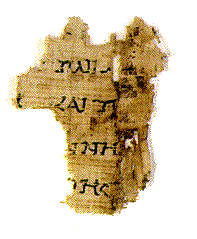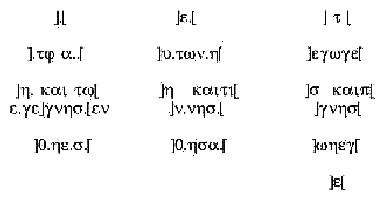Greek Qumran Fragment 7Q5:
Possibilities and Impossibilities
Carsten
Peter Thiede

The Greek scroll fragments from Qumran present a curious phenomenon: whereas the one Greek Old Testament papyrus from Cave 4 (supplemented by four Greek parchment scraps and one Exodus paraphrase on papyrus from the same cave) does not appear to belong to a separate collection, but to a general, motley, "library" preserved in that cave, the neighbouring cave 7 includes a collection in its own right -- nothing but nineteen Greek fragments, eighteen of them on papyrus, and another one preserved as an imprint in the hardened soil of the cave. A few months ago, the international scholarly debate about this cave has been given a new twist. Vittoria Spottorno, the new editor of the Spanish journal Sefarad, has published an article which claims to shed new light on the most important Greek papyrus fragment from Cave 7, "7Q5". In it, she proposes "una nueva posible identificacion de 7Q5", Zechariah 7,4-5 (1).
Her paper appeared a couple of months after the publication of the Eichst�tt University Qumran symposium, "Christen und Christliches in Qumran?" (2). At Eichst�tt, it had become apparent that there are more arguments in favour of the identification of 7Q5 as Mark 6,52-53 -- a New Testament identification first suggested as long ago as 1972 by the Spanish papyrologist Jos� O'Callaghan (3) -- than had previously been supposed by a majority of scholars. Above all, it was the detailed analysis presented by the Vienna papyrologist Herbert Hunger in favour of the Marcan identification which did not fail to impress the participants (4). As an aftermath of the symposium, fragment 7Q5 was analyzed in the forensic laboratory of the Department of Investigations at the Israel National Police in Jerusalem. The upper remnant of a decisive diagonal stroke be made visible in line 2 and further contributed to the solidity of the Marcan identification (5).
It is thus highly likely that 7Q5 = Mark 6,52-53 will have to be added to the official list of New Testament papyri sooner or later. On the other hand, attempts to suggest alternative identifications remain legitimate, even if -- or perhaps especially when -- they are carried out in ignorance of the results obtained at Eichst�tt and Jerusalem. To try and find an Old Testament (LXX) passage for 7Q5 is neither new nor original (6), not least in view of the fact that a fragment from Exodus (7Q1 = Exod 29, 4-7) and one from the deuterocanonical Letter of Jeremiah (7Q2 = EpistJer 43-44) -- two texts of some importance to early Christianity -- had already been identified among the 7Q papyri (7).
It is, however, not only Hunger's paper and the forensic analysis in Jerusalem that have recently added to the arguments in favour of 7Q5 = Mark 6,52-53; O'Callaghan's identification was checked by the Ibykus computer programme with the result that there is no other text than Mark 6,52-53 in extant Greek literature which fits the papyrological evidence of 7Q5 (8). Any alternative suggestion must therefore be expected to come up with corrections or improvements of at least equal value and importance as those represented by the Marcan "status quo". As this tiny scroll fragment offers a mere twenty letters on five lines (9), the scope for convincing alternative readings is understandably limited.
A juxtapostion of the editio princeps, O'Callaghan's reading, and Spottorno's alternative highlights the problem:
Editio princeps O'Callaghan Spottorno

O'Callaghan's dot underneath the nu in line 2 may now be deleted; the Jerusalem analysis proved its existence beyond the shadow of a doubt. However, this nu is not part of Spottorno's suggestions, anyway.
The extremely damaged letter in line 1 was not even tentatively identified in the editio princeps (10), even though the working hypothesis of an epsilon was admitted. On the other hand, it cannot possibly be a tau. This is obvious from a comparison with the undamaged tau in lines 2 and 3. Should one want to look for an alternative to epsilon in line 1, it might just conceivably be sigma.
It is thus equally impossible to read gamma instead of tau in line 2. The tau of 7Q5 is above suspicion and has been so as early as the editio princeps. The first and last letters of this line are severely damaged; even so, O'Callaghan's upsilon had been accepted as a possibility by the original editor (11). The eta, on the other hand, has gained further plausibility by the forensic analysis in Jerusalem (12). Therefore, Spottorno's variants are highly unlikely, if not downright impossible.
As for line 3, both O'Callaghan and Spottorno read kai after a spatium, i.e., paratactically. O'Callaghan's eta is confirmed by the editio princeps and indeed by all published enlargements, incuding an infrared photograph (13). By definition, Spottorno's sigma must be ruled out as impossible. Prior to Spottorno, only Aland had thought of reading pi instead of tau + ... at the end of this line (14), but without any serious argument in his favour.
In line 4, there are no differences suggested by Spottorno; however, she wants to find a justification for her reading of ea]n nHs[ teusHte (as in Zech 7,5) by seeing "las dos n de linea 4" as "discontinuas". Fragment 7Q5 does in fact offer two exceptions to the rule of scripto continua; they indicate small gaps between words -- in line 2 (autwn hH of Mark 6,52) and in line 3 (kai ti of Mark 6,53). That small gap in line 3 is part of the undamaged centre of the fragment; thus it can be compared accurately to the writing of the two nu in line 4. It should be obvious to the naked eye, even without the analysis of enlargements, that the "gap" between the two nu in line 4 is anything but proper spacing. Otherwise, even the undisputed kai in line 3 could not be a kai, since the "space" between kappa and alpha is as wide as, if not wider than, that between the two nu.
In line 5, O'Callaghan and Spottorno have only one letter in common, the second one, eta. It might just be possible to admit Spottorno's omega as a remote alternative, even though no one, beginning with the editio princeps, has ever seen it before. Sigma instead of epsilon for the third letter was one of the two possibilities suggested in the editio princeps; the remnants appear to belong to a curvature, however, and would be much too high for the horizontal stroke of an eta. As for the practically invisible trace of the last letter in this line, it is severely damaged by a turning to the right of the papyrus, probably caused by an early attempt at destruction (15). It is hardly possible to suggest, let alone identify any letter at all. Personally, I should have preferred a mere dot, but O'Callaghan's alpha (contrary to the sigma of the editio princeps) is supported by a concrete textual suggestion. Mark 6,52-53. Thus, if the papyrological and palaeographical evidence of the complete fragment supports the identification, as seems to be the case especially after Eichst�tt and Jerusalem, it must be allowed to stand. In principle, the same would be true, needless to say, of Spottorno's nu; but, as we have seen, her alternative identification is doomed already on the basis of irrefutable evidence against other letters of her reading. Furthermore, she adds a sixth line to the fragment and sees an epsilon in it. Original as this addition may be, it is hampered by the papyrus itself: there simply is not enough extant material to allow for a sixth line, let alone for a letter -- any letter -- in it.
As we have seen, Spottorno's alternative identification is ruled out by insurmountable palaeographcial barriers. There may be scope for debate in one or two secondary cases, but decisive letters pass an unequivocal verdict on her attempt.
All this is further corroborated by a look at the actual passage which she suggests in place of Mark 6,52-53, Zech 7,4-5, and which should be, as we have seen, according to the text of her own reconstruction, 7,3b-5. To begin with, there would be no justification for the undoubtable and undoubted paratactical kai after a spatium. And, as Spottorno herself admits (16), the text presupposed by her identification cannot be reconciled with any existing critical edition; neither Rahlf's (1979) nor any of the others corroborate what she suggests as the text of Zech 7,(3b)-5. Admittedly, she may have remembered a seemingly comparable problem in 7Q5 = Mark 6,52-53 (17). However, the singular variants in Mark make sense and could even be expected, as has been shown more than once (18), whereas Spottorno's variants stem from an extreme and philologically unjustifiable eclecticism. Thus, she does not even try to find reasons for them. For example, there is the omission of twn dunamewn in 7,4; the impossibility of a spatium before kai in 7,4; the addition of ths ghs between hiereis and legwn in 7,5; tw pemptw instead of tais pemptais and tw hebdomw instead of tais hebdomais in 7,5.
The sheer number of these variants invalidates Spottorno's attempt to improve upon 7Q5 = Mark 6,52-53. Her suggestion is to be rejected as impossible for palaeographical as well as philological reasons.
Institut fur Wissenschaftstheoretische Carsten Peter THIEDE Grundlagenforschung Busdorfwall 16 D-33098 Paderborn
Footnotes
(1) V. SPOTTORNO, "Una nueva posible identificacion de 7Q5", Sefarad 52 (1992) 541-543. Correctly, however, her suggestion involves 7,3b-5.
(2) B. MAYER (Hrog.), Christen und Christliches in Qumran? (Regensburg 1992). This volume contains the most up-to-date photographs of Qumran fragment 7Q5 on p.41, 242 and 243 (enlargement of nu detail, cf. n.5). Photographs of 7Q5 can also be found in Bib 53 (1972). J. O'Callaghan, Los papiros griegos de la cueva 7 de Qumran (as in n.13) and in C.P. THIEDE, The Earliest Gospel Manuscript? Qumran Fragment 7Q5 and its Significance for New Testament Studies (as in n.8). The first published photograph of 7Q5 was part of the original DJD III edition (cf. n.7), vol. 2, Planches, planche XXX, no. 5.
(3) J. O'CALLAGHAN, "Papiros neotestamentarios en la cueva 7 de Qumran?", Bib 53 (1972) 91-100. Authorized English Translation by W.I. Holladay: JBL 91 (1972), Suppliment 1-14.
(4) H. HUNGER, "7Q5: Markus 6,52-53 -- oder? Die Meinung des Papyrologen", Christen und Chrisliches, 33-56, with 22 ill.
(5) C.P. THIEDE, "Bericht uber die kriminaltechnische Untersuchung des Fragments 7Q5 in Jerusalem, Christen und Christliches, 239-245, with 4 ill.
(6) Detailed documentation and analysis in F. ROARHIRSCH, Markus in Qumran? Eine Auseinandersetzung mit den Argumenten fur und gegen das Fragment 7Q5 mit Hilfe des methodischen Fallibilismuprinzips (Wuppertal-Zurich 1990) 106-128.
(7) Les 'Petites Grottes' de Qumran (ed. M. BAILLET - J.T. MILIK -R. DeVAUX, OP) (DJD III; Oxford 1962) 142-146.
(8) Cf. C.P. THIEDE, The Earliest Gospel Manuscript? The Qumran Papyrus 7Q5 And Its Significance for New Testament Studies (Exeter-Carlisle 1992) 40-41, n.31.
(9) For the sake of comparison: 7Q2 = EpistJer 43-44 has twenty-two letters on five lines; Masada fragment 721a = Virgil Aeneid 4:9, has fifteen letters on one line.
(10) DJD III, 144.
(11) O'CALLAGHAN, Los papiros griegos.
(12) THIEDE, "Bericht", 240.
(13) J. O'CALLAGHAN, Los Papiros griegos de la Cueva 7 de Qumran (Madrid 1974) infra-red englargement of 7Q5 on plate VI, infra-red photographs of other 7Q fragments on plates IV and V.
(14) K. ALAND, "Neue neutestamentliche Papyri III", NTS 20 (1974) 357-381, here 375.
(15) See THIEDE, "Bericht", 240.
(16) SPOTTORNO, "Una nueva posible identificacion", 543.
(17) Omission of epi tHn gHn in 6,53 suggested by stichometry; tau instead of delta in tiaperasantes in 6,53.
(18) Most recently by HUNGER, "7Q5: Markus 6,52-53; -- oder?" and C.P. THIEDE, "Papyrologische Anfragen an 7Q5, im Umfeld antiker, Handschriften", Christen und Christliches,57-72. See also ROHRHIRSCH, Markus in Qumran?, 73-83, and THIEDE, The Earliest Gospel Manuscript?, 29-32.